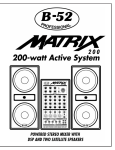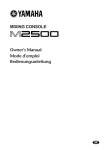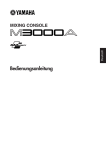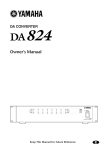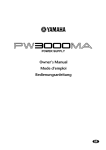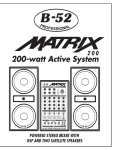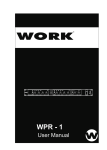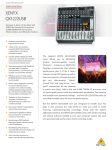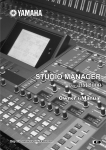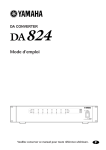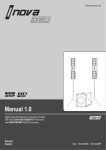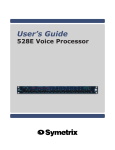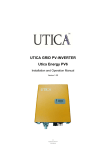Download Yamaha Music Mixer mixing consoles User's Manual
Transcript
MIXING CONSOLES -24/-32/-40C/-48C/-56C When discerning sound-reinforcement professionals think “console” they also think “Yamaha.” And with good reason. Yamaha soundreinforcement consoles have, for many years, been standards by which others are judged. Yamaha’s new M2500 consoles up the ante once more, defining new levels of performance, control, versatility, and reliability for an industry that never stands still. Innovate features such as the group/aux flip function and LCR panning offer unprecedented control, while no-compromise circuit design, layout, and component selection from the critical head amplifiers right through to the output connectors ensure that you get the cleanest, most accurate signal possible. The most important and in-demand features have all been implemented as well: 4-band EQ with two sweepable mid-bands on all mono inputs, a matrix submix of the group, auxiliary, stereo and mono/center busses as well as the sub inputs, 128-scene memory, 100-millimeter faders, and more. ■ A wide range of input configurations for all applications: 24, 32, 40, 48, or 56 mono inputs with 4 stereo inputs. ■ A total of 25 output busses: 8 group, 14 auxiliary, 1 stereo, and 1 mono/center buss. ■ Full-length 100-mm faders for all group masters and aux sends 1 through 6 — the group master faders/controls and aux send 7 through 14 controls can be flipped for maximum system versatility. ■ Group/auxiliary flip function allows the master section to be instantly optimized for main or monitor mixing. ■ Mono channel pan controls switchable for LR or LCR operation. ■ All mono inputs feature switchable phantom power, 26-dB pad switches, 44-dB gain trim, high-pass filter switches, and versatile 4-band EQ. ■ 128 mute scenes recallable via numeric keys, 8 direct recall switches, or MIDI control for mute automation. ■ The 8 direct recall switches can alternatively be used as mute group switches. ■ 13 x 8 submix matrix mixes the group/aux, stereo, and mono busses, as well as the L and R sub input signals, to 8 discrete outputs. ■ Odd/even group assign as well as stereo and mono buss assign switches on all input channels. ■ Aux sends 3 through 14 switchable for pre- or post-fader operation. ■ All outputs are balanced: stereo, mono/center, group, aux, monitor, and matrix out. ■ Insert patch points on all mono channels as well as the stereo, mono/center, group, and aux busses. ■ 11 large illuminated VU meters for precise visual level monitoring. ■ 3-point input level indicators on all input channels. ■ High-capacity, high-performance external power supply with full power monitoring (two can be connected for automatic switchover in case of failure). Photo: M2500-56C All of the mono inputs and group master controls feature LCR switches which, when engaged, assign the related panpot to the left, right, and center busses for LCR panning rather than just to the left and right busses as for standard LR stereo panning. When an LCR switches is not engaged, the corresponding PAN control functions in the normal way, panning the signal from left to right on the stereo buss. When a channel’s LCR switch is engaged, however, the center panpot position directly feeds the channel signal to the MONO/C buss, which can feed a center amp/speaker system as required, while intermediate pan positions feed both the L or R and C buss proportionately. The advantage is that centered signals are heard precisely in the center of the sound field, regardless of listening position — an ideal situation for vocals, speech, etc. (,while intermediate pan positions feed both ● L R PAN ● LCR PAN the L or R and C buss proportionately.) Intermediate pan pot positions pan between L L C C R R L&C when left of center and C&R when posiMONO/C BUSS@@ STEREO BUSS L@@ STEREO BUSS R tioned right of center. Signal Level This innovative feature makes it possible to flip the functions of the group master 1 through 8 controls (including pan pots, assign switches, and insert I/O jacks) with aux send controls 7 through 14 via a single switch. When the GROUP/AUX FLIP switch is set to GROUP, the 100-mm group master faders and related controls function in the normal way, affecting the signal fed to the console’s group outputs — the ideal configuration for most house mixing applications. When the GROUP/AUX FLIP switch is set to AUX, however, the group master faders are flipped with rotary aux sends 7 through 14, so that all of the console’s master aux sends are controlled via full-length faders for unmatched monitor mixing convenience. Switchable LR and LCR Panning Signal Level Group/Aux Flip Function STEREO INPUTS MONO INPUTS INPUT CHANNELS ■ Inputs ■ 14 Aux Sends The mono input channels feature balanced XLR-type microphone/line inputs. +48V Phantom power is independently switchable for all mono inputs, providing direct compatibility with high-performance phantompowered condenser microphones and DI boxes. Stereo line sources can be directly connected to any of the 4 stereo input channels (a total of eight inputs). Stereo channel 1 has switchable “A” or “B” inputs: the “A” inputs are balanced XLR type connectors, and the “B” inputs are standard RCA pin jacks type for compatibility with the widest possible range of line sources. Stereo channels 2 through 4 have balanced TRS inputs. The AUX 1 through AUX14 controls are mono auxiliary sends, feeding the corresponding auxiliary busses. The AUX 7 through AUX 14 signals can be re-routed to the group master controls, as described in the “MASTER CONTROLS” section, below. AUX 1 and AUX 2 are hard-wired pre-fader, while the remaining 12 sends can be switched to receive the preor post-fader signal in groups of four. ■ Channel Insertion Insert send/return patch points are included on all mono channels for convenient insertion of compressor/limiters (a must for top-quality vocal sound), equalizers, or any other outboard equipment you might need to apply to individual channels. ■ Input Controls & Level Matching Gain trim controls with a 44-dB range on all mono inputs, independent 40-dB gain controls for the A input on stereo channel 1 and stereo channels 2 through 4, and 30-dB gain controls for the B input on stereo channel 1, facilitate optimum level matching with a wide range of sources. The mono inputs additionally feature 26-dB pad switches and phase switches for easy input phase correction. ■ Filters & Flexible 4-band Channel EQ All mono channels feature a switchable high-pass filters to effectively eliminate rumble and other low-frequency noise. The mono channels also feature a very flexible 4-band equalizer which provides sweepable frequencies for the HI MID and LO MID bands. The stereo channels offer 2-band shelving EQ. EQ bypass switches are provided on all channels so equalization can be punched in or out as required without having to change settings. ■ Buss Assign & Pan/Balance Controls All mono and stereo channels have odd/ even assign switches for the 8 group busses, as well as stereo and mono buss assign switches. The mono channels have PAN controls switchable for LR or LCR operation, and the stereo channels have balance controls. ■ 3-point Level Indicators All mono and stereo channels feature 3point input level indicators for accurate monitoring of pre-fader signal levels. SIGNAL, NOM (nominal), and PEAK LEDs provide a broader “view” of channel signal levels than the usual one- or two-LED indicators. ■ Channel Faders, Pre-fader Listen, & Channel ON Switches Smooth, noise-free 100-mm linear faders make it easy to set up the optimum balance between channels, while PFL (Pre-Fader Listen) switches allow convenient solo monitoring of the channel’s pre-fader signal. All channels additionally feature ON/EDIT switches and indicators that can be used to switch the channel signal into or out of the mix — allowing editing of mute scenes, for example — without changing any other settings. MASTER CONTROLS ■ Master Auxiliary Sends ■ Sub Inputs Master auxiliary sends 1 through 6 feature full-length 100-millimeter faders with ON and AFL switches, and theses directly feed the corresponding AUX outputs. Master auxiliary sends 7 through 14 are normally rotary controls with ON and AFL switches, feeding the corresponding AUX outputs, but these can be flipped with the 100-millimeter faders and related controls normally assigned to the 8 group busses. Sub inputs to the stereo L and R busses, the mono/center buss, and the submix matrix allow external line-level signals to be added to the mix as required. ■ Group Master Controls All 8 group master faders are full-length 100-mm types with ON/EDIT switches and indicators, AFL switches, PAN controls, MATRIX assign, STEREO assign, MONO assign, and LCR panning mode switches. These group controls, in conjunction with the flippable aux master controls, lets you configure the console to meet your group/auxiliary requirements while retaining full use of all 25 output busses. ■ Group/Aux Flip Switch Flips the functions of the master group controls (1 through 8) with aux send masters 7 through 14. This makes it possible to to instantaneously optimize the master control section for main or monitor mixing applications. ■ All Balance Outputs with Insert Patching All outputs from the M2500 console — stereo, mono/center, group, aux, monitor, and matrix out — are electronically balanced for full compatibility with professional equipment and optimum performance with long signal runs. The group/aux, aux, stereo, and mono outputs also feature insert patch points for external signal processing. ■ 128 MIDI Scene Memory & 8 Mute Groups In the M2500 console the channel, group/ aux, stereo, and mono/center buss mute functions are electronically controlled by a microcomputer and MIDI interface. Up to 128 mute “scenes” can be stored in memory and recalled either via the panel controls or an external MIDI device. Eight DIRECT RECALL switches can be used for instant recall of the most often-used scenes, while others can be recalled via the numeric keys. The memory contents can be checked and edited at any time without actually affecting the mix. In addition to recalling complete scenes, external MIDI control can be used to individually turn the applicable channels and busses off or on as required. A MIDI sequencer or computer, for example, could be used for complete mute automation. And since the M2500 also transmits MIDI program change messages whenever a scene is recalled, it can be linked to MIDI-controllable signal processors so that appropriate effects are recalled automatically. Furthermore, scene data can be dumped to a MIDI data recorder or other storage device for long-term storage. ■ Submix Matrix The matrix mix concept was a Yamaha innovation which has virtually become an industry standard in professional audio consoles. The M2500 features a 13 x 8 matrix mix which allows the 8 group/aux buss signals, the stereo signals, the mono buss signal, and the L and R sub input signals to be mixed to eight balanced outputs for extra stage monitor mixes, zoned speaker mixes, or just about any type of mix the job requires. All eight matrix mixes include mix on/off switches and AFL switches. ■ Flexible Monitoring & Metering In addition to balanced stereo monitor outputs, the M2500 consoles feature a balanced mono/center monitor output for an extra margin of monitoring versatility. There’s also a separate headphone output with its own level control. A L+R switch sums the left- and right-channel signals when you want to monitor in mono via the stereo monitor outputs. A total of 11 large illuminated VU meters with built-in peak-reading LEDs provide accurate visual level monitoring. Eight of the meters can be switched to display levels on the group busses, aux busses, or the matrix outputs. The remaining three meters show levels on the stereo and mono/center busses. ■ Oscillator/Talkback Module For talkback the M2500 features a panelmounted microphone jack with level control and on/off switch. For convenient system calibration and testing there’s even a built in oscillator with 100Hzm 1kHz, 10kHz and pink noise output. ■ Lamp Connectors Connectors for up to three Yamaha LA1800 (option) console lamps are provided on the rear panel. PW3000MA Power Supply PW3000MA Specifications A newly developed, high-performance PW3000MA power supply unit is available as an optional accessory for the M2500 mixing console. Two PW3000MA units can be parallel connected so that if one fails the other will automatically take over — with no need for any extra automatic switchover equipment. Power consumption U.S. and Canadian model: 120V AC,60Hz / 500W 600 VA European model: 230V AC, 50Hz/ 500W Australian model: 240V AC, 50Hz/ 500W Dimensions (H × D × W) 103.5 × 455 × 480 mm (4-1/16” × 17-5/16” × 18-7/8”) Weight 15kg (33.1 Ibs) Accessory Connecting cable (1m) × 1 Rear Panel M2500-24Front Panel M2500-24 Rear Panel M2500-40C Front Panel M2500-40C Rear Panel –60dB –50dB –40dB –30dB –20dB –10dB 0dB +10dB +20dB +30dB (–26dB) (0dB) Pad:Off, Gain:Max Pad:On, Gain:Max Pad:Off, Gain:Min Pad:On, Gain:Min INPUT 1-24 1-32 1-40 1-48 1-56 ST CH 2-4 INPUT R L/MONO R INPUT B L R INPUT A L GAIN ST CH 1 26dB PAD 80 ST CH 1A, 2-4 Gain:Max ST CH 1B Gain:Max ST CH Gain:Min HPF GAIN A GAIN B GAIN B A Ø LO f ON/EDIT ON/EDIT 4 stage EQ HI-MID g LO-MID 2 stage EQ 2 stage EQ 2 stage EQ EQ EQ MIC Clipping Level MIC INSERT I/O from CPU CHECK ON 2 stage EQ Control HI from CPU CHECK ON f Control EQ TB/OSC PFL AUX 11-14 Same as AUX 3-6 from CPU ON PRE MONO ST AUX 7-10 Same as AUX 3-6 BAL PFL AUX 11-14 Same as AUX 3-6 ST CH 2-4 Same as ST CH 1 PEAK NOM SIGNAL PRE MONO ST AUX 7-10 Same as AUX 3-6 PAN 2 ** MIL to MIR MIO AUX6 AUX5 AUX4 AUX3 AUX2 AUX1 MONO ** * GROUP 3 5 7 4 6 8 MIM MIO AUX6 AUX5 AUX4 AUX3 AUX2 MONO to ST R ST L GROUP AUX 3 5 7 1 3 5 7 9 11 13 4 6 8 2 4 6 8 10 12 14 AUX1 2 ST L to ST R 1 to LCR 1 AUX 8-14 from AUX 2-6 INSERT I/O 0dB AUX 1 AUX GROUP from GROUP 2-8 ON/EDIT INSERT I/O 0dB G1/A7 ON AFL AFL MONO/C ST R ST L MMAM to MMPM MMAO * ** AUX OUT +4dB 1 GRP/AUX OUT AUX/GRP OUT SUB IN ST MONO AUX OUT SUB IN +4dB AUX 2-6 Same as AUX 1 ON to METER L R MONO * ** from INPUT MMAM to MMPM MMAO AUX/GRP OUT +4dB A7/G1 ** * to MATRIX LCR GRP/AUX OUT +4dB G1/A7 MMAM to MMPM MMAO MATRIX MONO ST to METER AFL GRP/AUX G2/A8-G8/A14 and AUX/GRP A8/G2-A14/G8 Same as G1/A7 and G7/A1 LEVEL from CPU GROUP/AUX FLIP Control CHECK ON PAN to METER LR CHECK ON from CPU from CPU Control INSERT I/O 0dB MONO/C ON/EDIT CHECK ON Control INSERT I/O 0dB ST R ON/EDIT INSERT I/O 0dB ST L ON AFL PINK G1/A7 G2/A8 ** * SUB IN +4dB MATRIX MMAM to MMPM MMAO ST OUT AFL MATRIX MATRIX MATRIX LR MATRIX METER SELECT G1-8/A7-14 AUX1-6 A7-14/G1-8 SUB IN MATRIX R L +4dB MONO/C ** ST OUT +4dB R MMAR MMPR to MONITOR to to MONITOR * ** ST OUT +4dB L MMAL to MMPL MMAO to MONITOR G8/A14 G7/A13 from OSCILATOR ON 100Hz 1kHz 10kHz LR SUB IN g LO LO G1/A7 G2/A8 G3/A9 G4/A10 G5/A11 G6/A12 G7/A13 G8/A14 PEAK NOM SIGNAL STEREO MONO/C INSERT I/O 0dB UTILITY SUB IN R SUB IN L MONO/C ST R ST L G8/A14 G7/A13 G2/A8 G1/A7 u q CHECK STORE RECALL from LEVEL ON AFL GRP/AUX, AUX/GRP AUX, ST MONO ST L ST L ST R ST R GRP/AUX, AUX/GRP AUX, ST MONO ST L, ST R IN OUT THRU Abbrev. MIM MIL MIR MIO MMPM MMPL MMPR MMAM MMAL MMAR MMAO MATRIX OUT LR LR LR INPUT MASTER PFL MASTER from MONO/C ST R ST L MONITOR bus MONITOR INPUT MONO MONITOR INPUT ST L MONITOR INPUT ST R MONITOR INPUT ON MONITOR MASTER PFL MONO MONITOR MASTER PFL ST L MONITOR MASTER PFL ST R MONITOR MASTER AFL MONO MONITOR MASTER AFL ST L MONITOR MASTER AFL ST R MONITOR MASTER AFL ON to TB to Control Mute Control OSC CPU *: MONITOR bus abbreviations MATRIX OUT +4dB 1-8 MIDI MONITOR MASTER INPUT (PFL) PFL AFL to METER DIRECT RECALL 8 7 2 1 MONO IN ST IN L ST IN R MONO IN, ST IN GRP/AUX, AUX/GRP AUX, ST MONO ENTER 0 9 2 1 MONO ST ON PHANTOM +48V MASTER MONO ST MONO ST ON HI HI L+R PHONES LEVEL G8/A14 MATRIX 8 A14/G8 G7/A13 MATRIX 7 A13/G7 MATRIX 6 A12/G6 AUX 6 G6/A12 MATRIX 5 A11/G5 AUX 5 G5/A11 MATRIX 4 A10/G4 AUX 4 G4/A10 MATRIX 3 A9/G3 AUX 3 G3/A9 MATRIX 2 A8/G2 AUX 2 G2/A8 MATRIX 1 A7/G1 AUX 1 G1/A7 ON Phones MONITOR OUT –60dB –50dB –40dB –30dB –20dB –10dB 0dB +10dB +20dB MONO/C R MONITOR OUT +4dB L BLOCK DIAGRAM STEREO MONO/C Input specifications Connection PAD 0 CH INPUT (1~n)*8 26 0 26 ST CH 1A INPUT [L, R] ST CH 1B INPUT [L, R] ST CH INPUT [L, R] (2~4) Gain Trim Actual Load Impedance −60 50–600 Ω Mics & 600 Ω Lines 3 kΩ −16 −30 +10 −20 +10 −30 +10 TALKBACK IN MATRIX SUB IN [L, R] 5 kΩ 600 Ω Lines 10 kΩ 600 Ω Lines 5 kΩ 600 Ω Lines 10 kΩ 50–600 Ω Mics 10 kΩ STREO [L, R], MONO/C SUB IN 600 Ω Lines Sensitivity *9 Nominal Connector In Mixer Max before Clip −80 dB (0.078 mV) −60 dB (0.775 mV) −54 dB (1.55 mV) −34 dB (15.5 mV) −40 dB (7.75 mV) −14 dB (155 mV) −36 dB (12.3 mV) −16 dB (123 mV) +4 dB (1.23 V) −10 dB (245 mV) +10 dB (2.45 V) +30 dB (24.5 V) −50 dB (2.45 mV) −30 dB (24.5 mV) −10 dB (245 mV) −10 dB (245 mV) +10 dB (2.45 V) +30 dB (24.5 V) −40 dB (7.75 mV) −20 dB (77.5 mV) 0 dB (0.775 V) −10 dB (245 mV) +10 dB (2.45 V) +30 dB (24.5 V) XLR-3-31 type *2 RCA Pin Jack *3 −50 dB (2.45 mV) −30 dB (24.5 mV) −10 dB (245 mV) −10 dB (245 mV) +10 dB (2.45 V) +30 dB (24.5 V) −66 dB (0.388 mV) −50 dB (2.45 mV) −20 dB (77.5 mV) XLR-3-31 type *5 +4 dB (1.23 V) +24 dB (12.3 V) Phono Jack (TRS) *6 0 dB (0.775 V) +20 dB (7.75 V) Phono Jack (TRS)*7 −2 dB (0.616 V) −6 dB (388 mV) Phono Jack (TRS)*4 −26 dB (38.8 mV) CH INSERT IN (1~n) *8 STEREO [L, R], MONO/C INSERT IN GRP/AUX INSERT IN (1/7~8/14) AUX INSERT IN (1~6) *1 *2 *3 *4 *5 Input Level *1 For Use With Nominal 10 kΩ 600 Ω Lines −10 dB (245 mV) In these specifications, when dB represents a specific voltage, 0dB is referenced to 0.775Vrms. XLR connectors are balanced. RCA Pin Jacks are unbalanced. INPUT Phone Jacks (TRS) are balanced (T= HOT, R= COLD, S= GND). XLR connector is unbalanced. *6 *7 *8 *9 SUB IN Phone Jacks (TRS) are unbalanced (T= SIGNAL, R= GND, S= GND). INSERT Phone Jacks (TRS) are unbalanced (T= OUTPUT, R= INPUT, S= GND). n= 56, 48, 40, 32, or 24. Sensitivity is the lowest level that will produce an output of +4dB (1.23V), or the nominal output level when the unit is set to maximum level. Output specifications Actual Source Impedance STEREO OUT [L, R] MONO/C OUT GRP/AUX OUT (1/7~8/14) AUX/GRP OUT (7/1~14/8) AUX OUT (1~6) MONITOR OUT [L, R, MONO/C] MATRX OUT (1~8) CH INSERT OUT (1~n)*5 STEREO INSERT OUT [L, R] MONO/C INSERT OUT GRP/AUX INSERT OUT (1/7~8/14) AUX INSERT OUT (1~6) PHONES OUT [L, R] For Use With Nominal Output Level *1 Nominal Max before Clip Connector In Mixer 150 Ω 600 Ω Lines +4 dB (1.23 V) +24 dB (12.3 V) XLR-3-32 type *2 600 Ω 10 kΩ Lines 0 dB (0.775 V) +20 dB (7.75 V) Phone Jack (TRS) *3 8 Ω Phones 10 mW 20 mW 40 Ω Phones 30 mW 75 mW 100 Ω *1 In these specifications, when dB represents a specific voltage, 0dB is referenced to 0.775 Vrms. *2 All XLR connectors are balanced. *3 INSERT Phone Jacks (TRS) are unbalanced (T= OUTPUT, R= INPUT, S= GND). M2500 Dimensions Stereo Phone Jack *4 *4 Stereo Phone Jack is unbalanced. *5 n= 56, 48, 40, 32, or 24. 265 (10-7/16") 23 (7/8") 270 (10-5/8") 270 (10-5/8") 137 (5-3/8") 242 (9-1/2") 875 (34-7/16") Connection M2500-24: 1400 (55-1/8") M2500-32: 1642 (64-5/8") M2500-40C: 1899 (74-3/4") M2500-48C: 2142 (84-5/16") M2500-56C: 2385 (93-7/8") Unit : mm(inch) General specifications Total Harmonic Distortion (Master output) Less than 0.1% (THD + N) 20 Hz–20 kHz @ +14 dB 600 Ω Frequency Response (Master Output) 0 + 1, –3 dB 20 Hz–20 kHz @ +4 dB 600 Ω (Input Gain control at Minimum) Hum & Noise *1 −128 dB −99 dB −64 dB (68 dB S/N) −80 dB (84 dB S/N) −81 dB (85 dB S/N) −75 dB (79 dB S/N) −90 dB (94 dB S/N) Crosstalk −70 dB −70 dB −50 dB Rs = 150 Ω (20 Hz–20 kHz) Input sensitivity=-60 dB Equivalent Input Noise. Residual Output Noise. (STEREO OUT, MONO/C OUT, GROUP/AUX OUT, AUX OUT, AUX/GROUP OUT) STEREO OUT Master Level control and one Ch fader at nominal level. STEREO OUT, MONO/C OUT Master fader at nominal level and all Ch assign SW’s off and all GROUP to ST SW’s off. GROUP 1/AUX 7~GROUP 8/AUX 14 OUT Master Level control at nominal level and all Ch assign SW’s off. GROUP/AUX FLIP SW off. AUX 1~6, AUX 7/GROUP 1~AUX 14/GROUP 8 OUT Master Level control at nominal level and all Ch send controls at minimum. GROUP/AUX FLIP SW off. MATRIX OUT Master level control at nominal level and all Matrix Mix controls at minimum level. @ 1 kHz adjacent inputs. @ 1 kHz input to output. (CH INPUT) @ 1 kHz input to output. (ST CH INPUT) Maximum Voltage Gain *GROUP/AUX FLIP SW = off 60 dB CH INPUT to CH INSERT OUT 84 dB CH INPUT to GROUP 1/AUX 7~GROUP 8/ AUX 14 OUT 80 dB CH INPUT to AUX 1, 2 OUT (Pre Fader) 90 dB CH INPUT to AUX 3~6, AUX 7/GROUP 1~ AUX 14/GROUP 8 OUT (Post Fader) 84 dB CH INPUT to STEREO OUT (CH to ST) 70 dB CH INPUT to MONITOR OUT (PFL) CH INPUT PAD SW 26 dB CH INPUT GAIN control 44 dB variable ST CH 1A, 2–4 INPUT GAIN control 40 dB variable ST CH 1B INPUT GAIN control 30 dB variable CH INPUT High Pass Filter CH INPUT Equalization +15, −15 dB maximum HIGH HIGH-MID LOW-MID LOW ST CH INPUT Equalization +15, −15 dB maximum HIGH LOW Phantom Power +48VDC is applied to balanced inputs (via 6.8 kΩ current-limiting/isolation resistors) for powering condenser microphones ; may be turned ON or OFF via rear-panel phantom Master switch. When Master is ON, individual channels may be turned ON or OFF via +48V switches (with red LED) on each input channel. CH LED Indicators PEAK NOM SIGNAL ST CH LED Indicators PEAK NOM SIGNAL LED (red) built into each ST CH INPUT turns on when pre-fader [L+R] level reaches +17 dB. LED (yellow) built into each ST CH INPUT turns on when pre-fader [L+R] level reaches 0 dB. LED (green) built into each ST CH INPUT turns on when pre-fader [L+R] level reaches −13 dB. Oscillator/Noise Switchable sine wave @ 100 Hz, 1 kHz or 10 kHz, or pink noise. Scene Memory Direct Scene Memory recall switches (1–8) Switchable Scene Memory recall (1–128) VU Meters 11 illuminated meters (0VU= +4 dB output @ 600 Ω load) #1 ; GROUP 1/AUX 7, AUX 1, AUX 7/GROUP 1, MATRIX 1 #2 ; GROUP 2/AUX 8, AUX 2, AUX 8/GROUP 2, MATRIX 2 #3 ; GROUP 3/AUX 9, AUX 3, AUX 9/GROUP 3, MATRIX 3 #4 ; GROUP 4/AUX 10, AUX 4, AUX 10/GROUP 4, MATRIX 4 #5 ; GROUP 5/AUX 11, AUX 5, AUX 11/GROUP 5, MATRIX 5 #6 ; GROUP 6/AUX 12, AUX 6, AUX 12/GROUP 6, MATRIX 6 #7 ; GROUP 7/AUX 13, NONE, AUX 13/GROUP 7, MATRIX 7 #8 ; GROUP 8/AUX 14, NONE, AUX 14/GROUP 8, MATRIX 8 #9 ; STEREO L, PFL/AFL L #10; MONO/C #11; STEREO R, PFL/AFL R VU Meter Peak Indicators LED (red) built into each VU meter turns on when output signal is above the level 3 dB lower than clipping level. Dimension Height Depth Width 18 dB/octave roll-off below 80 Hz at −3 dB point. Weight 10 kHz (shelving) 400–8 kHz (peaking) 80–1.6 kHz (peaking) 100 Hz (shelving) LED (red) built into each CH INPUT turns on when pre-fader level reaches +17 dB. LED (yellow) built into each CH INPUT turns on when pre-fader level reaches 0 dB. LED (green) built into each CH INPUT turns on when pre-fader level reaches −13 dB. 265 mm (10-6/7”) 875 mm (34-3/8”) Except rear connectors 56C: 2385 mm (93-7/8") 48C: 2142 mm (84-5/16") 40C: 1899 mm (74-3/4") 32: 1642 mm (64-5/8") 24: 1400 mm (55-1/8") 56C: 102 kg (224.9 Ibs.) 48C: 93 kg (205 Ibs.) 40C: 84 kg (185.2 Ibs.) 32: 71 kg (156.5 Ibs.) 24: 62 kg (136.7 Ibs.) Accessory Connecting cable (3 m) × 1 10 kHz (shelving) 100 Hz (shelving) ● 0 dB is referenced to 0.775 Vrms. *1 Hum & Noise are measured with a 6 dB/octave filter @ 12.7 kHz; equivalent to a 20 kHz filter with infinite dB/octave attenuation. YAMAHA Web Site http://www.yamaha.co.jp/english http://www.yamaha.co.jp/product/proaudio/homeenglish/ All specifications subject to change without notice. This document is printed on chlorine free (ECF) paper. For details please contact: LPA436 991223 Printed in Japan










